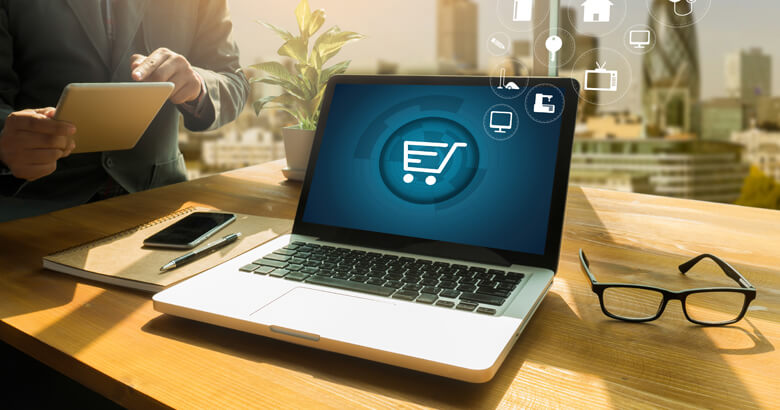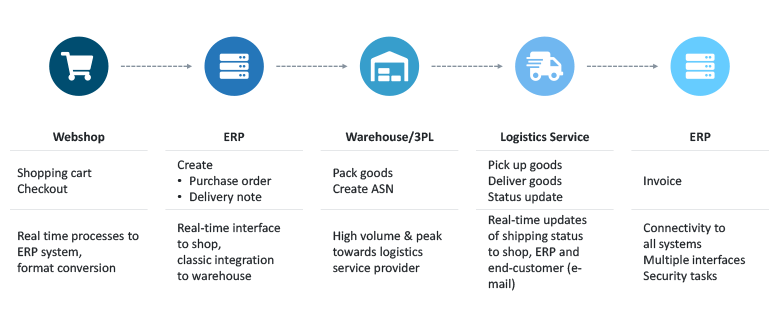
Are you harnessing the full power of digitalisation in your e-commerce strategy? This article looks at how integration solutions can help you grow your business online, get to know and understand your customers better, and give them real value.
In this four-part blog series, we start by looking at what B2B e-commerce is and what integration solutions could support a good e-commerce strategy. The second part considers the advantages of e-commerce and the benefits of digitalisation for you as a (future) online shop operator. In the third part, the series continues with seven tipps for a successful e-commerce strategy before the fourth part concludes with what you should look out for when integrating your systems for B2B e-commerce.
What is e-commerce?
E-Commerce is short for electronic commerce and refers to buying and selling on the internet. It is essentially any type of online trading, regardless of whether potential customers are using a PC, smartphone or tablet.
What is the difference between B2C and B2B-e-commerce?
A distinction is made between B2C and B2B e-commerce as the applications and solutions for a B2C online shop are fundamentally different to those for a B2B online shop. This is because a shop selling to other businesses (B2B) has different purchase options and processes to a shop selling to end consumers (B2C). As a result, the shops need different integration solutions. This article focusses on B2B e-commerce.
Trends in B2B e-commerce
E-Commerce is becoming a worthy contender to more traditional retail. Back in 2018, B2B e-commerce in Germany generated billions in sales[1]. In 2020, online sales grew by 27.6% worldwide[2]. And it just keeps growing. Various bodies have forecast that the B2B e-commerce market is likely to increase by 20% within just a few years, surpassing the B2C market by 2027[3]. This e-commerce trend is echoed worldwide.
Innovative technologies, new channels and rich media advertising help companies gain a foothold in a new market more quickly. Naturally, it’s also important to know what customers expect in terms of service and user experience. After all, customers will only stay with a shop if it develops a good customer relationship and trust with them long-term[4].
Mobile commerce and social commerce – new forms of e-commerce
There are already new forms of e-commerce, such as mobile commerce or social commerce. Mobile commerce refers to wireless communication with smartphones or tablets, such as through a shopping app. In social commerce, customers rate products on platforms such as rating portals or blogs through comments or likes. The aim is to get potential customers interested in products or services by using a variety of communication channels.
Digital solutions for B2B e-commerce
Behind an excellent B2B e-commerce sales process is an intelligently integrated network of systems and digital information. Once the many systems involved can smoothly interact and share data with each other, you can rise above your competitors by offering an amazing customer experience.
 Figure 1: The building blocks of multichannel and omnichannel commerce
Figure 1: The building blocks of multichannel and omnichannel commerceA comprehensive e-commerce strategy may involve integrating the following elements:
What do you need for e-commerce? Let’s start with an online shop.
So that your customers can see your goods online, you need an online shop. There are many different options, from rental models (part of the XaaS – ‛as a Service’ movement) to all-in-one solutions and even open-source offerings. The model you choose will depend on your specific needs and circumstances. Your web shop then needs to be integrated with your other systems, whether through a suitable interface or using a pre-built connector.
How do you sell your products on an e-commerce marketplace or auction site?
As well as running a web shop, you may also wish to offer your products on existing online marketplaces. These work similarly to traditional marketplaces and tend to be very well-known. They are a good way to reach new customers and advertise your products to a wider audience.
How do you take payments in B2B e-commerce?
Simple yet extremely secure payment is a must in e-commerce. Try to offer a variety of payment methods – four to five is best – rather than just one option. This reduces the likelihood of a customer walking away from a purchase at the last moment. Financial transactions in B2B e-commerce can be fully automated which benefits both sides.
How is my enterprise resource planning system involved in e-commerce?
An enterprise resource planning (ERP) system supports a company‘s business processes. When integrating a web shop with an ERP system, it would need to access elements for order processing, procurement, production, sales, asset management, human resources, finance and accounting, logistics. These share a database. Once an order enters the ERP system, it is forwarded, checked and confirmed. The ERP system also checks whether a product is available, where it is stored and the best way to get it to the customer.
How is warehousing affected by e-commerce?
Even if the ordering and processing is online, most goods are still in physical warehouses. This is where internet orders are shipped from. As a rule, these warehouses need to be able to receive and process a large number of orders, preferably error-free. You may also need to consider same-day delivery and other elements of Q-commerce when integrating your warehouses and logistics processes.
Harnessing CRM for good customer relationships in B2B e-commerce
Integrating a customer relationship management (CRM) system lets you seamlessly interact with customers and manage their data.
How do you manage data for e-commerce?
Data management, i.e. organising and maintaining product data, is an important issue in e-commerce. A distinction is made between product information management (PIM), digital asset management (DAM), media asset management (MAM) and media data management (MDM).
A product information system (PIM) contains all the information a company holds on a particular product. Pictures, videos and product details can all be stored in a PIM and shown to customers browsing the online shop. Automation and artificial intelligence can help to make it easier to prepare this information for different channels. Digital asset management and media asset management are similar formats: DAM manages assets in any media, including text while MAM is mostly used to store and organise rich media data. Media data management is essentially master data management and it is where you will find any sensitive customer data.
The following example illustrates how helpful these systems can be. Imagine that you are a B2B company selling a wide range of screws to corporate customers via an online shop. In order to manage the many background processes this entails, it makes sense to integrate a number of systems into a comprehensive e-commerce solution. As well as integrating a PIM system into your ERP system, you can link up a CRM system to manage your customer data and ensure you are addressing their order preferences, such as keeping their favourite products in stock. Naturally, once your customers have ordered some screws, these need to be shipped. You can make this easier by integrating warehouse and logistics systems. Then, to ensure that your stock is replenished on time, you can get your supply chain management solution talking to your suppliers’ systems. And finally, why not use e-invoicing to automate your billing process? Quickly, simply and digitally.
Integration solutions for a holistic B2B e-commerce strategy
We have now looked at a variety of systems which support a comprehensive e-commerce strategy. In the following, we look at how integrating these systems creates a holistic digital ecosystem for your B2B e-commerce.
Electronic data interchange and e-commerce complement each other
EDI stands for electronic data interchange and refers to an automated exchange of business documents as structured data between trading partners. Typical documents sent via EDI include B2B orders, order confirmations, delivery notifications, goods receipt notifications and invoices. It is also used for shipping documents.
Many companies see EDI as a gateway to digital transformation. Both EDI and e-commerce involve digital order processing. If you intend to establish an online business, it makes sense to integrate your existing EDI solution into an e-commerce solution to exploit the full potential of both systems.
E-Invoicing seamlessly processes your B2B e-commerce invoices
E-invoicing lets you digitally process orders and payments on one system with no manual intervention. It creates, issues and transmits invoices.
Integrating SAP add-ons
You could also integrate your SAP systems. Interesting SAP add-ons include Omni-Channel to Cash, a solution which goes from an incoming order to receiving payment, and smart-eInvoice®-Outbound, an add-on for fully automated invoice dispatch.
Integration in B2B e-commerce
There are various ways of linking and integrating the systems described above. Figure 2 illustrates how this could work.
 Figure 2: Example processes behind an online store.
Figure 2: Example processes behind an online store.The systems above are all connected by either an API or a connector
Application Programming Interfaces (APIs) give your B2B e-commerce a competitive edge
APIs are interfaces between separate applications. They are used to integrate both internal and external applications and systems. In supply chain management, for example, an API may provide real-time information on stock levels or current price information. You could also use an API to call up details from a PIM system for your online shop, to ensure your customers always have the most up-to-date information.
Pre-built connectors
Another great way to integrate different systems is to use pre-built connectors. The SEEBURGER Business Integration Suite lets you connect a huge range of e-commerce systems. The simple EAI/API solution, for example, lets you connect applications such as PlentyMarkets Connectivity or PayPal, while the BIS RestService Adapter provides Magento connectivity or lets you link Shopify to your e-commerce system.
Successful omnichannel selling with system integration
Would you like your bricks-and-mortar retail, your e-commerce business and your other sales channels to work together in harmony? An integrated retail strategy can get all of your sales channels singing together. Your strategy will need to be:
- Comprehensive: connect all of your systems.
- In real time: for extremely up-to-date information on availability, prices, order and delivery status, product information etc.
- Automatic: digital and automated order processing, re-ordering, management of customer and product information and much more via your systems ensures smooth and error-free processes.
- Synchronised: all your channels showing the same information at the same time.
The SEEBURGER Business Integration Suite is a central integration platform for connecting all of your systems. It lets you meet the high, changing demands of e-commerce from one central place.
 Figure 3: How the SEEBURGER BIS can support your e-commerce needs
Figure 3: How the SEEBURGER BIS can support your e-commerce needsE-Commerce: the future of B2B trade is digital
B2B e-commerce is growing fast and is now an integral part of our digital age. The end-to-end integration provided by the SEEBURGER Business Integration Suite (BIS) gives you a robust, scalable foundation upon which to grow your e-commerce business and add new systems as needed. Say goodbye to a tangle of point-to-point mappings. All the systems, applications and cloud services that need to work together to give your customers an excellent user experience are integrated together on one platform – including your suppliers‘ systems as necessary.
Real-time integration keeps your systems and information right up-to-date, for you and your trading partners. This lets you meet the ever higher customer expectations for speed and accuracy. And, as online business continues to experience rapid growth, a robust, scalable platform which lets your systems communicate in real time is a definite future-proof investment.
[1] cf. https://de.statista.com/statistik/daten/studie/254040/umfrage/b2b-e-commerce-umsaetze-nach-marktteilnehmern/ (accessed31.01.2022).
[2] cf. E-commerce growth statistics – UK, US and Worldwide forecasts (smartinsights.com) (accessed 01.02.2022).
[3] cf. 81 Relevant B2B Statistics: 2021/2022 Market Share Analysis & Data – Financesonline.com (accessed 04.02.2022).
[4] Cf. Georg Wittmann, Holger Seidenschwarz, Sabine Pur: B2B-E-Commerce 2020 – Status quo, Erfahrungen und Ausblicke. Ergebnisse einer Expertenbefragung [B2B e-commerce 2020 – status quo, experiences and outlook. Results of an expert survey] by ibi research at Universität Regensburg, Creditreform, eCube and Spryker. December 2019.
Source: https://blog.seeburger.com/b2b-e-commerce-and-integration-101/
 expertise
expertise
